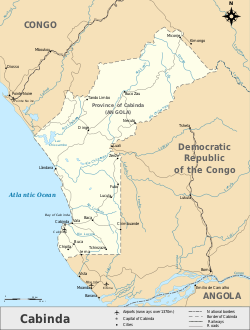Cabinda Province
Cabinda (formerly called Portuguese Congo, Kongo: Kabinda) is an exclave and province of Angola, a status that has been disputed by several political organizations in the territory.In 1885, the Treaty of Simulambuco established Cabinda as a protectorate of the Portuguese Empire, and Cabindan independence movements consider the occupation of the territory by Angola illegal.Portuguese explorers, missionaries, and traders arrived at the mouth of the Congo River in the mid-15th century, making contact with the Manikongo, the powerful King of the Bakongo tribe.Over the years, the Portuguese, Dutch, and English established trading posts, logging camps, and small palm oil processing factories in Cabinda.Article 1, for example, states, "the princes and chiefs and their successors declare, voluntarily, their recognition of Portuguese sovereignty, placing under the protectorate of this nation all the territories by them governed" [sic].A 1974 military coup in Lisbon abolished the authoritarian regime established by António de Oliveira Salazar that had prevailed in Portugal for decades.The treaty was rejected by the Front for the Liberation of the Enclave of Cabinda and other local political organizations which advocated for separate independence.In fact, the majority of Organization of African Unity (OAU) members, concerned that this could encourage separatism elsewhere on the continent,[citation needed] committed to the sanctity of state borders and firmly rejected recognition of the FLEC's government in exile.[citation needed] In January 1975, Angola's MPLA, FNLA and UNITA liberation movements signed the Alvor Agreement with Portugal, to establish the modalities of the transition to independence.[citation needed] On 1 August 1975, at an OAU summit in Kampala which was discussing Angola in the midst of its turbulent decolonization process, Ranque Franque proclaimed the independence of the "Republic of Cabinda".[citation needed] Following the declaration of Angolan independence in November 1975, Cabinda was invaded by forces of the Popular Movement for the Liberation of Angola (MPLA), with the support of Cuban troops.For much of the 1970s and 1980s, FLEC operated a low intensity guerrilla war, attacking Angolan government troops and economic targets, or creating havoc by kidnapping foreign employees working in the province's oil and construction businesses.[citation needed] An ad-hoc United Nations commission for human rights in Cabinda reported in 2003 that many atrocities had been perpetrated by the MPLA.In 2004, according to Peter Takirambudde, executive director of the Human Rights Watch mission for Africa, the Angolan army continued to commit crimes against civilians in Cabinda.Rodrigues Mingas, secretary general of the Front for the Liberation of the Enclave of Cabinda-Military Position (Flec-PM), said his fighters had meant to attack security guards as the convoy passed through Cabinda."[19] Consisting largely of tropical forest, Cabinda produces hardwoods, coffee, cocoa, crude rubber, and palm oil.During 1999, FLEC-R kidnapped four foreign workers (two Portuguese and two French citizens), but released them after several months, having failed to attract the attention of the international community.

ProvinceCountryAngolaAlvor AgreementCapitalCabindaProvincial governmentEugénio César LaborinhoISO 3166 codeRepublic of the CongoDemocratic Republic of the CongoexclaveBelizeBuco-ZauCacongoN'GoyoLoangoKakongoUnited States governmentstatisticsBelgian CongoFrench CongoAtlantic Oceanoffshore oil fieldsPetroleum explorationPortuguese rulehardwoodscoffeerubberpalm oilpetroleumSonangolChevronTotalEnergiesTreaty of SimulambucoprotectoratePortuguese EmpireAngolan Civil WarRepublic of CabindaEduardo CamavingamissionariesCongo RiverManikongoBakongo tribeEnglishtrading postsloggingImperial Brazilian Navynaval baseBas-CongoPortuguese Crownself-determinationFront for the Liberation of the Enclave of CabindaBerlin ConferenceCongo Free Stateoverseas provinceoffshoremilitary coup in LisbonAntónio de Oliveira SalazardecolonizationTreaty of AlvorNational Liberation Front of Angolajoint venturesCabinda WarBakongoKikongoMovement for the Liberation of the Enclave of CabindaLuis Ranque FranqueémigréBrazzavilleAlliamaMayombegovernment in exileOrganization of African Unitythe continentKampalaindependenceZairianMobutu Sese Sekoprovisional governmentHenriques TiagoPopular Movement for the Liberation of Angolalow intensityguerrilla warPortugueseUnrepresented Nations and Peoples Organizationinternational organizationindigenous peoplesoccupied nationsad-hocUnited NationscommissionPeter TakirambuddeHuman Rights Watchcrimes against civiliansprice of oiloil reservesAntónio Bento BembeRussiaSouth KoreaEuropean UnionTogo national football team attackTogo national football team2010 Africa Cup of NationsRodrigues MingasTogoleseFrance 24Energy in AngolaPetroleum politicsCorruption in Angolatropical forestoil industryoil companiesFLEC-FACmunicipalitiescommunesMalemboTanto-ZinzeMassabiInhucaNecutoMicongeoil fieldspre-saltAptianBarremian
